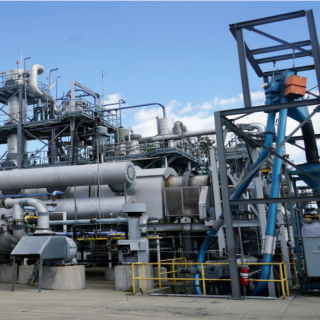Local powerbrokers have heralded New Albany’s planned Intel computer chip plant for the jobs it will bring to the region, but Intel’s plans for Central Ohio are also part of a wider campaign to maintain dominance over China.
On Christmas Day 2021, government officials in Ohio learned that Intel had selected New Albany for the location of its newest manufacturing mega-site. The Ohio legislature quickly mobilized at dizzying speeds to secure $1 billion in tax-payer money for infrastructure improvements including the expansion of State Route 161, expediting permit processes, and altering the tax law to extend tax abatements to 30 years for projects over $1 billion.
The $20 billion Intel factory with plans for a $100 billion expansion could become the largest semiconductor factory in the world, already breaking the record for the largest investment in the history of Ohio. It’s expected to transform the upper-class suburb of New Albany from a developing tech center to the “Silicon Heartland.”
“New Albany today versus the high-tech mega manufacturing center of the heartland in five years?” Intel CEO Pat Gelsinger told Time Magazine. “Yea, it’s going to be unrecognizable.”
Columbus Mayor Ginther praised the announcement and framed it as “an opportunity for equitable growth,” believing “we all benefit” from its presence, as the plant is expected to create 3,000 highly-skilled company jobs and 7,000 construction jobs. The actual chipmaking is scheduled to begin in late 2025, and one product will be the Intel 18A, which some experts believe could become the most advanced chip ever.
The Ohio legislature and Intel lobbyists have been pushing Congress to pass the CHIPS for America Act, a spending package which would earmark $52 billion in federal tax dollars to go towards subsidizing the building of computer-chip factories across the US, an essential investment, companies say, to compete in the global market.
In 2021 Intel grew at an underwhelming rate of 0.5 percent, while the industry average was 25 percent. Intel claims their underperformance will turn around with federal subsidies and new facilities, but critics say their business model is outdated compared to competitors and they’re increasingly becoming isolated as the major tech companies turn towards producing their own chips.
“This is not an industry where you just wake up and catch up,” Vivek Arya, a semiconductor analyst at Bank of America told Time. “It’s like trying to get back to being an Olympic level athlete – it doesn’t happen overnight.”
Intel’s largest competitors – Taiwan Semiconductor Manufacturing Co (TSMC) and Samsung – are both located in Eastern Asia, with TSMC boasting 54 percent of the industry’s global revenue. The pandemic caused major supply-chain disruptions that led to issues in industries like the American auto industry, causing them to pause or slow production, a problem the American semiconductor lobby hopes to address with domestic production. But critics point out that chips would nonetheless still be shipped abroad for assembly, packaging, and testing. Intel also isn’t the only multinational corporation capitalizing on the supply chain issue, both Samsung and TSMC have announced their plans for US factories. The US also sees a major issue being the proximity of TSMC and Samsung to China.
At a recent White House event U.S. Commerce Secretary Gina Raimondo said that the current semiconductor supply chain is “far too dependent on conditions and countries halfway around the world.” Biden emphasized that “China is doing everything it can to take over the global market so they can try to out compete the rest of us.”
At a summit between Biden and China’s president Xi Jinping, Biden emphasized the need to limit competition to the market, not military conflict, saying that it’s “our responsibility as leaders of China and the United States is to ensure that the competition between our countries does not veer into conflict, whether intended or unintended.”
Many were quick to highlight the contradictions of Biden’s statement as the hostile military presence of the US in the region has been escalating tensions between the US and China, contributing to what’s being called a new Cold War.
The US regularly sends warships through the South China Sea and the Taiwan Strait, has sold $1.8 billion in arms to Taiwan in 2020, landed multiple military planes and deployed special training forces, formed two alliances to counteract China’s trade routes (Quad and AUKAS, which includes supplying nuclear submarines to Australia), and launched sweeping sanctions against China. Almost half of the 173,000 US military members deployed abroad are stationed in neighboring Japan (53,700) and South Korea (26,400), with Japan having 120 US military bases and South Korea having 73. The largest military base overseas is in South Korea, Camp Humphreys, at 3,454 acres. China has no military bases or warships near the US.
Even domestically, the US has been arresting professors that do research in China, investing hundreds of millions of tax-payer dollars into propaganda campaigns and anti-China political movements through the National Endowment for Democracy, which the former NED president Allen Weinstein described as“[doing] today was done covertly 25 years ago by the CIA.” The continued anti-China rhetoric domestically has violently sparked a drastic spike in anti-Asian hate crimes.
Indian intellectual Vijay Prashad argues in an interview that “developments in China are an existential threat to the dominance of these Western firms, which are in areas such as telecommunications, robotics, high-speed rail, and new energy technology. It is the fear of losing supremacy in these key tech sectors that drives the ‘new cold war’ against China and prevents sober assessment of Chinese developments.”
If the US was solely concerned with market competition with China, it begs the question as to why the CHIP Act and Build Back Better Act haven’t been swiftly passed just as smoothly as the military budget, the most recent being $778 billion in December 2021. Intel’s Gelsinger confusedly asked the Undersecretary of Defense, “Why am I explaining why [building domestic chip factories] is so important to Congress, and you’re not?’”
Intel isn’t even sure that the Act will pass, which they say will slow the construction of New Albany’s plant.
Economic competition doesn’t exist in a vacuum. The US military expansion throughout the world hardly provides a free market as highlighted by a Beijing-based political analyst, Einar Tangen, who told Al Jazeera that Australia’s nuclear submarine pact has “echoes of gunboat diplomacy going back to the colonial era.”
Prashad argues that “The divide is not between China and the US, a division that the US is trying to impose on the world. The divide is between humanity and imperialism.” (A system of constant international expansion for the pursuit of increased profits.)
Intel’s New Albany mega-site is not just an economic attempt to compete with China and East Asia, or is it all about local job growth, but is also a small piece of a wider means of the US to maintain dominance over global trade through brute force and economic warfare.
---------------------------------------------
Taylor Dorrell is a contributing writer at Cleveland Review of Books, a reporter at the Columbus Free Press, a contributor to People’s World, and a member of the National Writers Union. You can see the rest of his work on his website: taylordorrell.com



